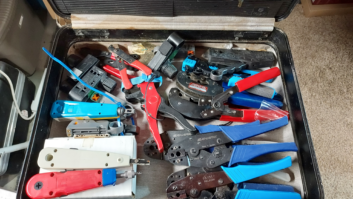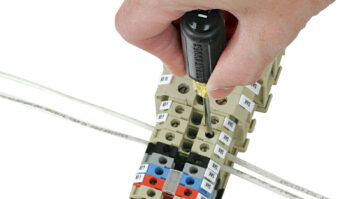(click thumbnail)Fig. 1: An Inexpensive Monitor Switch.Every once in a while, peruse those non-broadcast catalogs and you’ll come up with a “find.”
Ed Bukont of TESSCO shares just such a product from the Markertek Video Supply catalog.
The Niles RFS-1 is a voltage-activated A-B switch. The RFS-1 accommodates two RF inputs and provides a single RF output. Using a small RF relay, the default mode passes input “A” to the output.
Initially designed to switch between cable TV and a video game, the switch finds its way into the studio to free up monitor space. You can route two video sources into the switch, and save on the space for a second monitor.
Ed let me open up the RFA-1 and I was impressed. See Figure 1, and you will be, too. A high-quality PC board holds the components, and the design offers greater than 60 dB from 50 to 550 MHz. In/Out connections are made using an “f” connector. The relay uses 12 VDC for switching , and a control output connector is provided so multiple RFA-1s can be daisy-chained.
Contact the company at (800)522-2025 or www.markertek.com

. . .
(click thumbnail)Fig. 2: Neutrik makes inexpensive audio generators and analyzers.Compact test equipment is handy, and Figure 2 shows Neutrik’s solution.
The Minirator MR-1 and Minilyzer ML-1 should find a place in everyone’s tool kit. Brian Edwards, engineering manager for New World Radio in Washington, has added them to his tool bag.
The Minirator generates a variety of tones: sine, square, even pink noise. The Minilyzer measures the standard audio performance specs such as distortion and noise, but also displays audio spectrum, so the system can be used for acoustical work.
The MR-1 and ML1 are available from your favorite broadcast supplier.

. . .
John Stortz is the DOE for Moody’s Central Florida broadcasting stations. He had been having some problems with his CCA transmitter’s plate breaker tripping off. It was becoming frustrating, because it required someone to drive to the tower site and flip the breaker.
Finally, John decided to test the breaker and check its current-carrying trip points. The breaker is a 175A, three-phase.
At the transmitter building, John’s got an old high-voltage power transformer, which was in a 20 kW transmitter – before one of the secondaries shorted. When he had the time, John had been cutting the windings off for scrap. His assistant, Don Jeerings, advised him to keep the primaries and the iron core. The suggestion proved invaluable in testing the errant plate breaker.
They wound a car jumper cable three times around one of the primaries to make a high-current/low-voltage transformer. The secondary car jumper cable was then connected to each side of one of the circuit breaker sections at a time. To adjust the current, the 120VAC was supplied through a 50A Variac. This made a variable, high-current power supply, that would supply well over 300A, the maximum John’s clamp-on ammeter would read.
Testing the breaker, the engineers found that the center breaker section would not hold as well as the outer two. The outer breaker sections would hold 200A for about 25 seconds. The center section would not even hold 180A for 10 seconds.
The breaker was replaced, and the problem has not recurred. When you price new breakers, you will see that this extra investigative work was worth the time.
. . .
Everyone does microphone cables differently, but some of the differences have more than just an engineer’s preference in mind.
(click thumbnail)Fig. 3: Mic connectors can be mounted in a turret.
Jeff Twilley’s Delmarva Broadcasting studio rebuild project is now complete. Jeff chose to break up the mike wiring, so that his O.C. White stands are wired with a pigtail. The pigtailed XLR plugs into the jacks mounted on the side of the turret.
Figure 3 shows the finished work. Note that Jeff uses a larger diameter shrink tubing, secured with a wire tie, to prevent abrasion of the wires by equipment being slid into the rack.
(click thumbnail)Fig. 4: This rat’s nest of wiring is courtesy of the tenant.
By standardizing this method in all studios, if a microphone dies, the stand/mic/cable assembly is quickly moved from one studio to another. It’s plug and play! If you’ve ever had a jock cross-thread a mic onto a stand – trying to make the switch in your absence – you’ll understand the importance of this simplicity.


. . .
Figure 4 shows what you can expect when your GM rents out the transmitter site, without consulting you!
In this case, there were no provisions for the tenant to supply a rack, or use good engineering practice in running wire and coax. That’s part of the coax run, coiled up by the ladder!
Don’t know what will happen when the tube box is needed! Of course, all the manager saw was that $500 a month payment. If your manager is seeking tower rental revenue, that’s great. If you, as his engineer, are managing the site, make sure you get a commission for your efforts.
Review the proposed lease, and remember: if it’s not in writing, there is no guarantee it will be done. This includes providing an equipment rack and not performing a haywire cabling job!
Submissions for this column are encouraged, and qualify for SBE recertification credit. Fax your submission to (703) 323-8044, or send e-mail tojbisset@harris.












